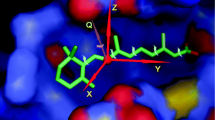Abstract
The prediction of the complex structure of a small ligand with a protein, the so-called protein–ligand docking problem, is a central part of the rational drug design process. For this purpose, we introduce the docking algorithm PLANTS (Protein–Ligand ANT System), which is based on ant colony optimization, one of the most successful swarm intelligence techniques. We study the effectiveness of PLANTS for several parameter settings and present a direct comparison of PLANTS’s performance to a state-of-the-art program called GOLD, which is based on a genetic algorithm and frequently used in the pharmaceutical industry for this task. Last but not least, we also show that PLANTS can make effective use of protein flexibility giving example results on cross-docking and virtual screening experiments for protein kinase A.
Similar content being viewed by others
References
Abagyan, R., Totrov, M., & Kuznetsov, D. (1994). ICM—A new method for protein modeling and design: applications to docking and structure prediction from the distorted native conformation. Journal of Computational Chemistry, 15(5), 488–506.
Baxter, C. A., Murray, C. W., Clark, D. E., Westhead, D. R., & Eldridge, M. D. (1997). Flexible docking using tabu search and an empirical estimate of binding affinity. Proteins, 33, 367–382.
Berman, H., Westbrook, J., Feng, Z., Gilliland, G., Bhat, T., Weissig, H., et al. (2000). The protein data bank. Nucleic Acids Research, 28, 235–242.
Clark, M., Cramer III, R. D., & van Opdenhosch, N. (1989). Validation of the general purpose tripos 5.2 force field. Journal of Computational Chemistry, 10, 982–1012.
Dorigo, M., & Stützle, T. (2004). Ant colony optimization. Cambridge: MIT Press.
Fischer, E. (1894). Einfluss der Configuration auf die Wirkung der Enzyme. Chemische Berichte, 27, 2985–2993.
Gehlhaar, D. K., Verkhivker, G. M., Rejto, P. A., Sherman, C. J., Fogel, D. B., Fogel, L. J., & Freer, S. T. (1995). Molecular recognition of the inhibitor AG-1243 by HIV-1 protease: conformationally flexible docking by evolutionary programming. Chemistry and Biology, 2, 317–324.
Halgren, T. A. (1996). Merck molecular force field, I: basis, form, scope, parameterization, and performance of MMFF94. Journal of Computational Chemistry, 17(5–6), 490–519.
Irwin, J. J., & Shoichet, B. K. (2005). ZINC—A free database of commercially available compounds for virtual screening. Journal of Chemical Information and Modeling, 45(1), 177–82.
Jones, G., Willett, P., Glen, R. C., Leach, A. R., & Taylor, R. D. (1997). Development and validation of a genetic algorithm for flexible docking. Journal of Molecular Biology, 267, 727–748.
Kellenberger, E., Rodrigo, J., Muller, P., & Rognan, D. (2004). Comparative evaluation of eight docking tools for docking and virtual screening accuracy. Proteins, 57(2), 225–242.
Kontoyianni, M., McClellan, L. M., & Sokol, G. S. (2004). Evaluation of docking performance: comparative data on docking algorithms. Journal of Medicinal Chemistry, 47(3), 558–565.
Koshland, D. E. (1973). Protein shape and biological control. Scientific American, 229(4), 52–64.
Korb, O., Stützle, T., & Exner, T. E. (2006). PLANTS: Application of Ant Colony Optimization to Structure-Based Drug Design. In M. Dorigo, L. M. Gambardella, M. Birattari, A. Martinoli, R. Poli, & T. Stützle (Eds.), Lecture Notes in Computer Science : Vol. 4150. Ant colony optimization and swarm intelligence, 5th international workshop, ANTS 2006 (pp. 247–258). Berlin: Springer.
McMartin, C., & Bohacek, R. S. (1997). QXP: powerful, rapid computer algorithms for structure-based drug design. Journal of Computer-Aided Molecular Design, 11(4), 333–344.
Morris, G. M., Goodsell, D. S., Halliday, R. S., Huey, R., Hart, W. E., Belew, R. K., et al. (1998). Automated docking using a Lamarckian genetic algorithm and an empirical binding free energy function. Journal of Computational Chemistry, 19, 1639–1662.
Müller, G. (2003). Medicinal chemistry of target family-directed masterkeys. Drug Discovery Today, 8(15), 681–691.
Nelder, J. A., & Mead, R. (1965). A simplex method for function minimization. Computer Journal, 7, 308–313.
Nissink, J. W. M., Murray, C., Hartshorn, M., Verdonk, M. L., Cole, J. C., & Taylor, R. (2002). A new test set for validating predictions of protein–ligand interaction. Proteins, 49(4), 457–471.
Press, W. H., Flannery, B. P., Teukolsky, S. A., & Vetterling, W. T. (1992). Numerical recipes in C: the art of scientific computing. Cambridge: Cambridge University Press.
Stützle, T., & Hoos, H. H. (2000). \(\mathcal{MAX}\) – \(\mathcal{MIN}\) ant system. Future Generation Computer Systems, 16(8), 889–914.
Taylor, R. D., Jewsbury, P. J., & Essex, J. W. (2002). A review of protein-small molecule docking methods. Journal of Computer-Aided Molecular Design, 16, 151–166.
Triballeau, N., Acher, F., Brabet, I., Pin, J.-P., & Bertrand, H.-O. (2005). Virtual screening workflow development guided by the “receiver operating characteristic” curve approach. Application to high-throughput docking on metabotropic glutamate receptor subtype 4. Journal of Medicinal Chemistry, 48(7), 2534–2547.
Verdonk, M. L., Cole, J. C., Hartshorn, M. J., Murray, C. W., & Taylor, R. D. (2003). Improved protein–ligand docking using GOLD. Proteins, 52, 609–623.
Verdonk, M. L., Berdini, V., Hartshorn, M. J., Mooij, W. T. M., Murray, C. W., Taylor, R. D., & Watson, P. (2004). Virtual screening using protein–ligand docking: avoiding artificial enrichment. Journal of Chemical Information and Modeling, 44(3), 793–806.
Verkhivker, G. M. (2004). Computational analysis of ligand binding dynamics at the intermolecular hot spots with the aid of simulated tempering and binding free energy calculations. Journal of Molecular Graphics and Modelling, 22, 335–348.
Author information
Authors and Affiliations
Corresponding author
Additional information
This article is based on a paper that won the best paper award at ANTS 2006, the 5th International Workshop on Ant Colony Optimization and Swarm Intelligence held in Brussels, Belgium, 2006. This article includes new types of experiments and also the possibility of considering flexibility of protein side-chains.
Rights and permissions
About this article
Cite this article
Korb, O., Stützle, T. & Exner, T.E. An ant colony optimization approach to flexible protein–ligand docking. Swarm Intell 1, 115–134 (2007). https://doi.org/10.1007/s11721-007-0006-9
Received:
Accepted:
Published:
Issue Date:
DOI: https://doi.org/10.1007/s11721-007-0006-9




